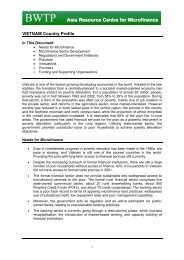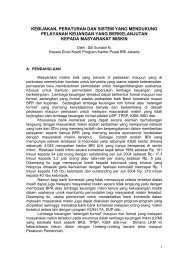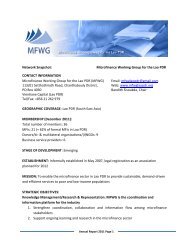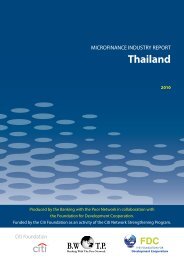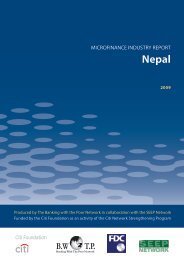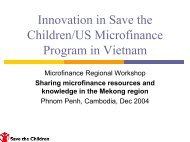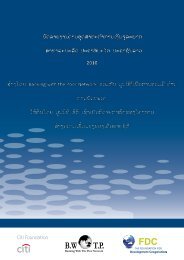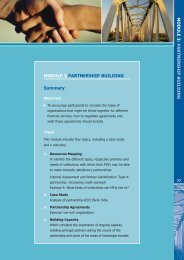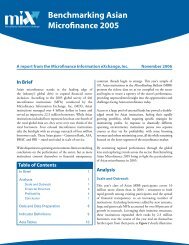microfinance industry report - Vietnam - Banking with the Poor Network
microfinance industry report - Vietnam - Banking with the Poor Network
microfinance industry report - Vietnam - Banking with the Poor Network
Create successful ePaper yourself
Turn your PDF publications into a flip-book with our unique Google optimized e-Paper software.
Table 1. Population and Demographic Data, Viet Nam, 2000-08<br />
2000 2005 2006 2007 2008<br />
Total Population (WDI/CIA 2008) 77.64m 83.10m 84.11m 85.2m 86.1m<br />
Population growth (WDI/CIA 2008) 0.2 1.3 1.2 1.2 0.99%<br />
Economically Active Population 69% 68.6% 68.6%<br />
Adult literacy rates (HDR 2007) (1995-2005) 90.3% 90.3% .. .. ..<br />
Life expectancy (WDI, 2008) 69 71 71 .. ..<br />
% of population below <strong>the</strong> national poverty line 19.5% .. 16% 14.2% ..<br />
Population density (ADB 2007) 236 252 254 257 ..<br />
% of population in rural areas (ADB 2007/GSO) 75.8 73.1 72.88 70% ..<br />
Human Development Index .. .. .. 0.733 ..<br />
Human Development Ranking (out of 177) .. .. .. 105 ..<br />
Sources: World Development Indicators (2008), Asian Development Bank (2007), Human Development Report (2007); GSO: Statistical Year Book of<br />
Viet Nam, 2007.<br />
Most low-income households are in rural areas 7 and<br />
are predominantly engaged in agricultural crop<br />
production and raising of small livestock, selling<br />
any surplus produce at <strong>the</strong> local markets. Most of<br />
<strong>the</strong>se households 8 (86%) have access to land. In<br />
addition to farming, at least 35% operate non-farm<br />
household businesses 9 . The improvement of physical<br />
infrastructure has contributed to <strong>the</strong> reduction of<br />
poverty. Similarly, access to irrigation, high-value<br />
crops (such as coffee, spices, shellfish or fish in<br />
addition to rice) and to a local market positively<br />
impacts income generation from both farm and<br />
non-farm activities.<br />
7 IMF: Country Report 07/386 Viet Nam, Statistical Appendix,<br />
December 2007.<br />
8 As <strong>microfinance</strong> is normally serving only one member of <strong>the</strong><br />
household, but benefiting <strong>the</strong> entire family, <strong>the</strong> market size is<br />
often given in number of households.<br />
9 World Bank: Viet Nam Development Report, 2004: Poverty.<br />
The GDP per capita income has risen over <strong>the</strong> past few<br />
years, from $410 in 2004 to $835 in 2007. However,<br />
<strong>the</strong>re is a large difference between <strong>the</strong> average per<br />
capita incomes of $793/year for urban residents and<br />
<strong>the</strong> rural average per capita income of $374/year<br />
(2006). Poverty is more strongly related to ethnicity<br />
than to geography and remoteness. In 2006, only 10%<br />
of Kinh and Chinese were poor, while 52% of ethnic<br />
minorities lived below <strong>the</strong> poverty line. Poverty is<br />
vastly more persistent in <strong>the</strong> nor<strong>the</strong>rn mountains,<br />
Central Highlands, and along <strong>the</strong> flood-prone delta<br />
coastlines where ethnic minority residents live.<br />
For <strong>the</strong> first time in 13 years, urban poverty is<br />
not declining. Currently, migrant workers receive<br />
lower wages, lack access to social protections such<br />
as health care, and <strong>the</strong>ir children cannot access<br />
education <strong>with</strong>out resident certificates.<br />
<strong>Banking</strong> With The <strong>Poor</strong> <strong>Network</strong> 7<br />
<strong>Vietnam</strong>e_Report_FOR_PRINT.indd 7<br />
27/05/2009 7:45:59 PM



